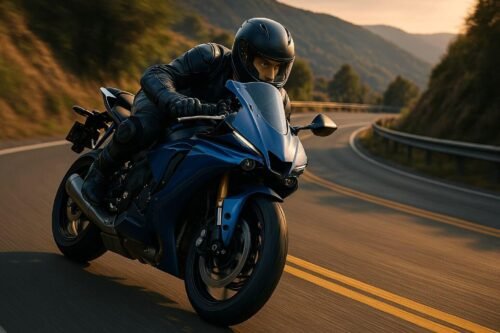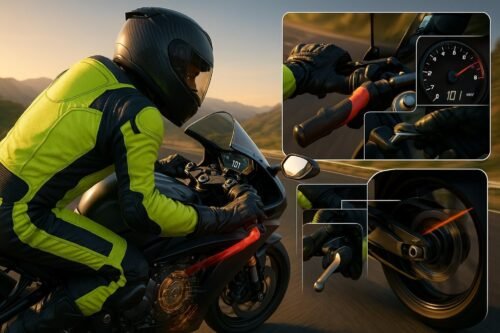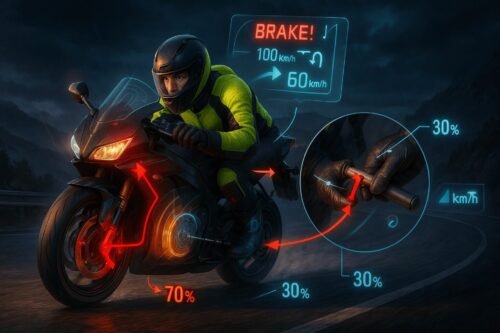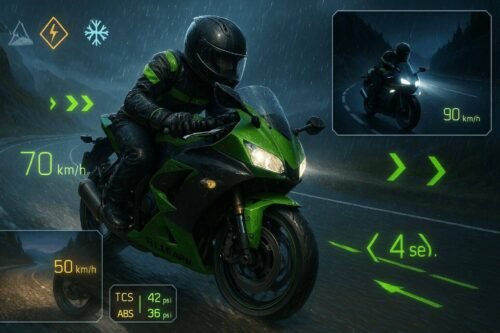Getting your snowmobile’s track adjusted correctly doesn’t have to be complicated. In this guide, we’ll show you the tools, step-by-step instructions, and troubleshooting tips for all major brands — Polaris, Ski‑Doo/Lynx, Arctic Cat, Yamaha, and more. If you do it right, your snowmobile will run great quickly. Why Track Tension Matters Track tension directly affects […]

7 Sportbike Riding Tips for New Riders: Ride with Confidence
Embarking on the journey of sportbike riding is both exhilarating and challenging. These high-performance machines offer unmatched agility and speed, but they also demand a heightened level of skill and awareness. To ensure a safe and enjoyable experience, it's crucial to master fundamental techniques and adopt best practices. Here are seven essential riding tips for new sportbike riders.
Table of Contents
7 Sportbike Riding Tips for New Riders
1. Perfect Your Body Position
A proper sportbike riding posture ensures control, balance, and safety.

Perfect your body position
Focus on three core principles:
Leaning Into Turns
Here is a useful experience: shift your upper body toward the inside of the turn while keeping the bike slightly upright.
This "counter-leaning" technique maximizes tire traction and prevents scraping footpegs.
So, the key is: avoid leaning the bike too far—let your body adjust first.
Head and Eyes Up
Remember: your gaze directs your ride.
Look through turns, focusing on the exit point, not the pavement.
This prevents target fixation (accidentally steering toward hazards)
and ensures smoother cornering.
Knee and Elbow Placement
Grip the tank with your knees to stabilize your lower body.
Keep your elbows slightly bent to absorb bumps and maintain steering flexibility.
In addition, you should avoid locking your arms. Because this may reduce the control.
Professional Tips
- Practice slow-speed drills (e.g., figure-eights, U-turns) to build muscle memory.
- Record your posture to spot imbalances like stiff elbows or uneven weight distribution.
- Mastering these basics boosts confidence in corners, straightaways, and emergency maneuvers.
2. Master Throttle Control

master throttle control
Throttle control is the key to harnessing a sportbike’s power safely. Follow these principles to avoid instability and maximize traction:
Progressive Roll-On
Technique: Roll the throttle open smoothly, like turning a dial—never jerk it. Gradual input prevents rear-wheel spin (critical in rain) or front-wheel lift.
Why It Works: Sudden twists shift weight abruptly. This can cause the motorcycle to feel unsettled in the mid-corner, and it will be harder for you to control it. Therefore, you should roll the throttle smoothly to keep the tires planted.
Practice: Try rolling the throttle by riding a motorcycle on a straight road can help you master the skill. You can practice accelerating from 30–60 mph while keeping the bike stable. Remember to focus on wrist control, not your arm strength.
Throttle Blipping
What is it?
A quick throttle “blip” while downshifting to match engine RPM to the lower gear.
What are the steps?
Why is it important?
It can eliminate jerky deceleration, ensuring stability during corner entry.
What are the mistakes to avoid?
You should avoid over-revving during the blip. This may cause abrupt engine braking.
Avoid Overloading the Front Wheel
Risk: Sudden acceleration lifts the front wheel (wheelie), reducing steering control.
Fix: Ease into throttle input, especially exiting corners. Let weight transition forward naturally.
Pro Tips
- Engine Braking: Roll off the throttle gently to slow down—ideal for wet roads or traffic.
- Tech Aid: Use ride modes (e.g., “Rain” mode on Kawasaki Ninja 650) to soften throttle response as you learn.
Master these techniques to transform raw power into precision.
3. Hone Your Braking Skills

Hone your braking skills
Effective braking is critical for sportbike safety. Here’s how to balance power and precision:
Front vs. Rear Brake Balance
- Technique: Use the front brake for 70–80% of stopping power (it compresses the front suspension, maximizing tire grip). Apply the rear brake lightly to stabilize the bike, especially in low-speed maneuvers.
- Why It Works: Weight shifts forward during braking, increasing front-tire traction. Overusing the rear brake can lock the wheel, causing skids.
- Mistake to Avoid: “Panic grabbing” the front brake—squeeze progressively to avoid wheel lockup.
Trail Braking
- What It Is: Gradually easing off the brakes as you lean into a corner.
- How to Do It: Begin braking before the turn, then reduce pressure as you tip the bike in. This maintains stability while entering corners at higher speeds.
- Why It Matters: Abruptly releasing brakes mid-turn can unsettle the suspension, leading to loss of control.
Pro Tip: Practice trail braking on familiar, smooth roads first. Avoid gravel or wet surfaces until you’re confident.
Emergency Braking
Technique:
- Squeeze the front brake firmly but smoothly.
- Apply light rear brake to stabilize.
- Keep the bike upright and eyes focused ahead.
Why Practice: Reflexive braking saves critical milliseconds. Modern ABS systems help prevent lockups, but muscle memory is irreplaceable.
Drill: In a parking lot, mark a stopping point. Accelerate to 40 mph, then brake hard, aiming to stop within the zone. Repeat to build consistency.
Pro Tip: Maintenance Matters
- Check brake fluid levels monthly—air bubbles reduce efficiency.
- Replace worn brake pads if thickness drops below 3mm.
- Inspect rotors for warping or grooves, which compromise stopping power.
4. Adjust Speed for Conditions

Adjust speed for conditions
Speed management isn’t just about going fast—it’s about adapting to your environment.
Situational Awareness
Weather and Road Surfaces: Reduce speed in rain, on gravel, or during cold mornings when tires lack grip. Wet roads can cut traction by 50%, increasing stopping distances.
Traffic Dynamics: Maintain a 3–4-second gap from vehicles ahead. Sportbikes accelerate quickly, but sudden stops from cars or debris require ample reaction time.
Curve Speed: Enter corners at a speed that allows you to accelerate out. Over-braking mid-turn can destabilize the bike.
Pro Tip: Use reflective gear and ensure your bike’s lights are functional for night rides, where visibility drops significantly.
5. Avoid Group Rides Initially

Avoid group rides initially
While riding with others can be fun, group dynamics add complexity that new riders may not handle safely.
Risks of Early Group Rides
Peer Pressure: Keeping up with experienced riders might push you beyond your skill level, leading to reckless decisions.
Formation Challenges: Staggered formations require coordination, and inexperienced riders might struggle with spacing or sudden stops.
Distractions: Focusing on others instead of the road increases accident risks.
Pro Tip: Build solo confidence first. Once comfortable, join small groups and communicate using hand signals or Bluetooth helmet systems for clarity.
6. Prioritize Mental Clarity and Focus

prioritize mental clarity and focus
Riding a sportbike demands 100% attention. Distractions or emotional turbulence can be fatal.
Strategies for Sharp Focus
Pre-Ride Rituals: Perform a T-CLOCS inspection (Tires, Controls, Lights, Oil, Chassis, Stands) to ensure mechanical soundness and clear your mind.
Avoid Impairments: Never ride under the influence of alcohol, fatigue, or stress. Even over-the-counter medications can dull reflexes.
Defensive Riding: Assume drivers don’t see you. Position yourself visibly in lanes and watch for turning vehicles or open car doors.
Pro Tip: Practice mindfulness techniques like deep breathing before rides to stay calm and alert.
7. Understand Your Bike’s Power Band
Mastering your sportbike’s power band—the RPM range where the engine delivers peak performance—ensures smoother acceleration, efficient overtaking, and longer component life. Here’s how to harness it:
Torque vs. Horsepower
- Torque: Provides low-RPM pulling power (e.g., accelerating from a stop). Ideal for city riding or tight corners.
- Horsepower: Dominates at high RPMs (e.g., 8,000+ RPM), crucial for top-speed runs or track straights.
- Sweet Spot: Learn where your bike’s power peaks (check the owner’s manual or dyno charts). For example, the Yamaha YZF-R3 hits its torque peak at 9,000 RPM.
Gear Selection Strategies
- Short-Shifting: Upshift early (below the power band) for relaxed city riding. Reduces wheelies and improves fuel efficiency.
- High-RPM Bursts: Downshift before overtaking or exiting corners to stay within the power band. Example: Drop to 2nd gear at 6,000 RPM for instant acceleration.
Engine Braking
- Technique: Downshift while rolling off the throttle to let engine resistance slow the bike. Match RPMs to avoid rear-wheel lockup.
- When to Use: Approaching red lights, descending hills, or slippery roads where brakes risk skidding.
Pro Tips
- Beginner Bikes: Models like the Kawasaki Ninja 400 offer linear power delivery, forgiving erratic throttle inputs.
- Tuning Tools: Aftermarket ECU flashes (e.g., Dynojet) can smooth abrupt power spikes in aggressive engines.
Common Mistake: Revving too high in low gears—this strains the engine and can cause instability.
Final Thoughts: Gear Up and Stay Curious
While these tips form the foundation, continuous learning is key. Enroll in advanced riding courses, track days, or online tutorials to refine your skills. Invest in DOT-certified helmets, armored jackets, and reinforced boots—ATGATT (“All The Gear, All The Time”) isn’t just a mantra; it’s a lifesaver.
Finally, choose a bike that matches your skill level. Lightweight models like the Honda CBR300R or Suzuki GSX250R offer manageable power and agility, letting you grow into your riding journey.
By combining technical mastery with situational awareness, you’ll unlock the full potential of your sportbike—safely and thrillingly.
You may also interested in: 3 Off-Road Skills You Should Practice Before Your Next Ride

Rodney L is a technical writer and product consultant with over a decade of experience in the motor industry. Rodney is a fan of performance machines that run fast and loud and an expert in all things custom. His numerous articles and write-ups are available at our knowledge base. Whether it’s something wrong with your motorcycle or you are building a custom bike, you can trust Rodney’s experience.
Motorcycle riding is all about the sense of freedom, adventure, and thrill of the open road. But come on—being connected when you ride isn't always an easy thing. Whether you're riding with a buddy, navigating traffic in the city, or long-distance riding, effective communication is crucial. That's where the Fodsports T5 and T6 come in, […]
If you're looking for a new motorcycle intercom system this year, Fodsports has something exciting in store. The company has launched two new Bluetooth helmet intercoms: T1 and T1 Pro. Both models bring upgraded features, sleek design, and high-definition audio quality for riders who want to stay connected, entertained, and safe on the road. But […]
Fodsports T1 and T1 Pro: The Newest Bluetooth Intercoms for Riders. Whether you’re cruising on highways, exploring rugged trails, or commuting daily, clear communication is key. Fodsports is thrilled to launch its latest Bluetooth intercoms: the T1 and T1 Pro. Built for riders who demand reliability, versatility, and crystal-clear sound, these devices redefine how you […]
Many riders who aren't so tall or ladies just starting to ride bikes need to pick out the best Motorcycles for Short Riders and Women. They gotta look for three key things: a seat that's not too high up, a bike that's not too heavy, and something that looks good enough to give them confidence. […]
Fodsports FX 60C vs FX30C Pro: What's new techs are the FX 60C bringing to us? Fodsports is a brand worth-mention for helmet communication and video recording. This brand has established itself as a key player with its innovative Bluetooth camera intercom systems. Recently, Fodsports has released a new camera intercom, the FX 60C. How […]
